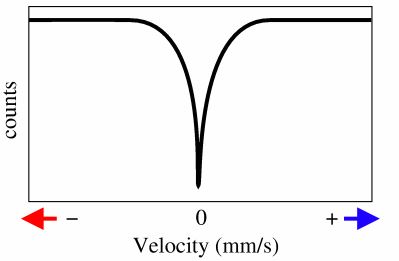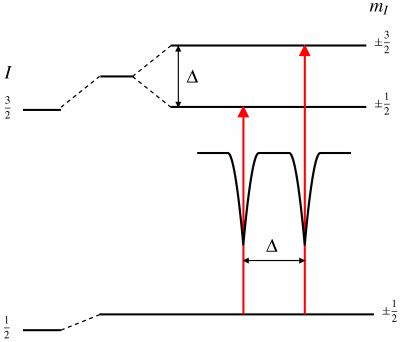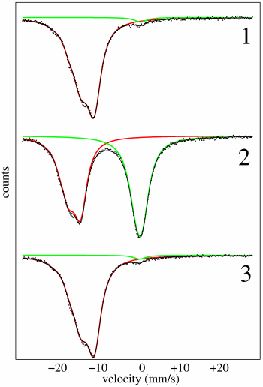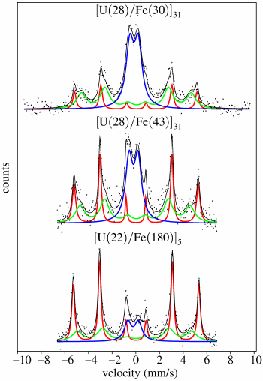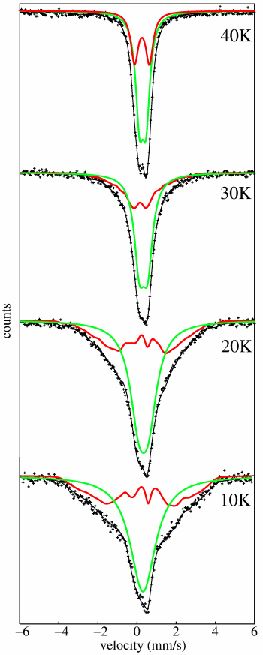The Mössbauer Spectroscopy Group has now been closed. For any enquiries please contact our Networks team.
Introduction to Mössbauer Spectroscopy
Mössbauer spectroscopy is a versatile technique that can be used to provide information in many areas of science such as Physics, Chemistry, Biology and Metallurgy. It can give very precise information about the chemical, structural, magnetic and time-dependent properties of a material. Key to the success of the technique is the discovery of recoilless gamma ray emission and absorption, now referred to as the 'Mössbauer Effect', after its discoverer Rudolph Mössbauer, who first observed the effect in 1957 and received the Nobel Prize in Physics in 1961 for his work.
This introduction to the theory and applications of Mössbauer spectroscopy is composed of four sections. First the theory behind the Mössbauer effect is explained. Next how the effect can be used to probe atoms within a system is shown. Then the principal factors of a Mössbauer spectrum are illustrated with spectra taken from research work. Finally a bibliography of books and web sites is given for further and more detailed information.
The Mössbauer Effect
Nuclei in atoms undergo a variety of energy level transitions, often associated with the emission or absorption of a gamma ray. These energy levels are influenced by their surrounding environment, both electronic and magnetic, which can change or split these energy levels. These changes in the energy levels can provide information about the atom's local environment within a system and ought to be observed using resonance-fluorescence. There are, however, two major obstacles in obtaining this information: the 'hyperfine' interactions between the nucleus and its environment are extremely small, and the recoil of the nucleus as the gamma-ray is emitted or absorbed prevents resonance.
In a free nucleus during emission or absorption of a gamma ray it recoils due to conservation of momentum, just like a gun recoils when firing a bullet, with a recoil energy ER. This recoil is shown in Fig1. The emitted gamma ray has ER less energy than the nuclear transition but to be resonantly absorbed it must be ER greater than the transition energy due to the recoil of the absorbing nucleus. To achieve resonance the loss of the recoil energy must be overcome in some way.

As the atoms will be moving due to random thermal motion the gamma-ray energy has a spread of values ED caused by the Doppler effect. This produces a gamma-ray energy profile as shown in Fig2. To produce a resonant signal the two energies need to overlap and this is shown in the red-shaded area. This area is shown exaggerated as in reality it is extremely small, a millionth or less of the gamma-rays are in this region, and impractical as a technique.
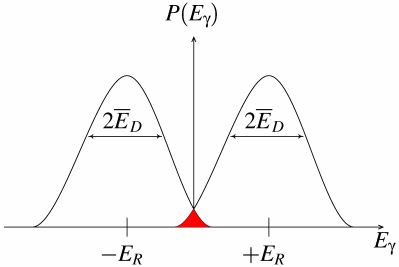
What Mössbauer discovered is that when the atoms are within a solid matrix the effective mass of the nucleus is very much greater. The recoiling mass is now effectively the mass of the whole system, making ER and ED very small. If the gamma-ray energy is small enough the recoil of the nucleus is too low to be transmitted as a phonon (vibration in the crystal lattice) and so the whole system recoils, making the recoil energy practically zero: a recoil-free event. In this situation, as shown in Fig3, if the emitting and absorbing nuclei are in a solid matrix the emitted and absorbed gamma-ray is the same energy: resonance!

If emitting and absorbing nuclei are in identical, cubic environments then the transition energies are identical and this produces a spectrum as shown in Fig4: a single absorption line.
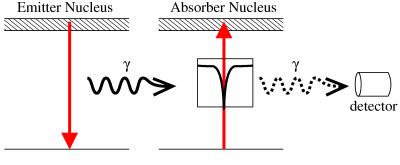
Now that we can achieve resonant emission and absorption can we use it to probe the tiny hyperfine interactions between an atom's nucleus and its environment? The limiting resolution now that recoil and doppler broadening have been eliminated is the natural linewidth of the excited nuclear state. This is related to the average lifetime of the excited state before it decays by emitting the gamma-ray. For the most common Mössbauer isotope, 57Fe, this linewidth is 5x10-9ev. Compared to the Mössbauer gamma-ray energy of 14.4keV this gives a resolution of 1 in 1012, or the equivalent of a small speck of dust on the back of an elephant or one sheet of paper in the distance between the Sun and the Earth. This exceptional resolution is of the order necessary to detect the hyperfine interactions in the nucleus.
As resonance only occurs when the transition energy of the emitting and absorbing nucleus match exactly the effect is isotope specific. The relative number of recoil-free events (and hence the strength of the signal) is strongly dependent upon the gamma-ray energy and so the Mössbauer effect is only detected in isotopes with very low lying excited states. Similarly the resolution is dependent upon the lifetime of the excited state. These two factors limit the number of isotopes that can be used successfully for Mössbauer spectroscopy. The most used is 57Fe, which has both a very low energy gamma-ray and long-lived excited state, matching both requirements well. Fig5 shows the isotopes in which the Mössbauer effect has been detected.
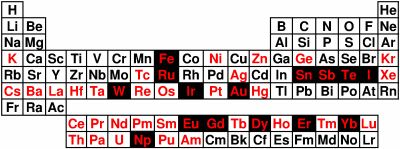
Armed with the Mössbauer effect and a suitable isotope how can we use these properties to investigate a system? This will be explained in Part 2.
Downloadable files
Related links
![]() Mossbauer Spectroscopy at Knox College
Mossbauer Spectroscopy at Knox College
The aim of this web site is to provide a concise reference of the theory and experimental features of this scientific method
![]() Science Engineering and Education Co
Science Engineering and Education Co
Formerly WEB Research Co, SEE Co offers hardware, software and Ritverc Gamma-ray sources for Mossbauer Spectroscopy
For any enquiries please contact our Networks team.
Contact the Networks Team


